by Julie Pigott Dillard | Mar 17, 2023
Over 50 4-Hers and over 100 chickens filled the barn and auditorium for the 2023 Northwest District Chick Chain show. The show was culmination of the seven month 4-H Chick Chain project.
At the beginning of the 4-H year, 4-Hers took ownership of day old chicks and began their journey in the 4-H poultry science project. They learned about poultry nutritional and housing needs, how to clean and show their birds, and how to perform health assessments. This program also encourages the development of life skills. Life skills are also known as workforce ready skills – skills that help individuals adapt to and perform in different settings.
Some of those workforce ready skills include:
- Communication – During the project, 4-Hers learned how to perform health checks on their birds. At the show, they conduct a health check for a judge. They explain to a judge how to perform the check, what they are looking for, and why a health check is important. 4-Hers could also choose to participate in Avian Adventures and give a presentation or demonstration on any aspect of poultry science.
- Problem Solving – 4-Hers participated in a skill-a-thon to test what they learned throughout the project. Senior 4-Hers were given scenarios to apply the best care and nutrition practices to meet the given situation.
- Work Ethic – Caring for an animal requires daily attention. 4-Hers fed and watered their animals daily, changed bedding, and prepared for cold temperatures to protect their birds. They also practiced their showmanship skills by frequently handling their birds to ensure they were tame.
- Reading and Mathematics – 4-Hers completed a record book at the end of their project. Their record books documented project goals, what they learned during the project, and animal care tasks. They also completed a financial record of expenses and income throughout the project.
At the show, all 4-Hers participated in poultry showmanship. First-time show participants and Cloverbuds participated in a skill-a-thon to test the knowledge and skills they learned in the project. 4-Hers who participated in last year’s Chick Chain show participated in Avian Adventures giving a presentation or demonstration on any poultry science related topic.
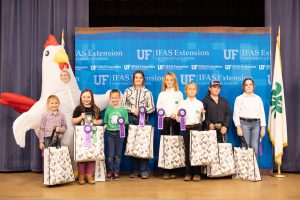
Best of Breed winners
2023 NWD 4-H Chick Chain Show Results
Best of Breed
- Australorp – Kolton Mercer
- Cochin – Emily Flowers
- Delaware – Tate Cannon
- Orpington – Olivia Bruan
- Plymouth Barred Rock – Tate Cannon
- Rhode Island Red – Henry Feinberg

Laura Mae – Grand Champion Pullet
- Sussex – Lily McDaniel
- Wyandotte – Laura Mae Waters
Grand Champion Pullet – Laura Mae Waters
Reserve Champion Pullet – Henry Feinberg
Grand Champion Production – Audrey Stephens
Reserve Champion Production – Kolton Mercer
Showmanship
- 1st place Junior – Julia Newsome

Audrey – Grand Champion Production
- 2nd place Junior – Jackson Scurlock
- 3rd place Junior – Kendyl Reams
- 1st place Intermediate – Julia Mashack
- 2nd place Intermediate – Emily Flowers
- 3rd place Intermediate – Emmit Ackman
- 1st place Senior – Steven Stafford
- 2nd place Senior – Roger Nemeth
- 3rd place Senior – Audrey Stephens
Skill-a-Thon

Julia – 1st place junior showmanship
- 1st place Cloverbud – Aubrey Mauldin
- 1st place Junior – Finn Feinberg
- 1st place Intermediate – Micah Houston
- 1st place Senior – JD Brookhouse
Avian Adventures Demonstration
- 1st place Junior – Allison Collier
- 2nd place Junior – Tate Cannon
- 1st place Intermediate – Kason Mercer
Avian Adventures Illustrated Talk
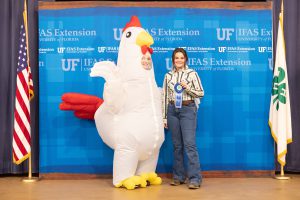
Emily – 1st Place Intermediate presentation
- 1st place Junior – Jocelyn Brock
- 2nd place Junior – Kadence Ackman
- 1st place Intermediate – Emily Flowers
- 2nd place Intermediate – Riley Bolling
- 3rd place Intermediate – Eli Howard
- 1st place Senior – Cat Proud
- 2nd place Senior – Roger Nemeth
- 3rd place Audrey Stephens
To all of our exhibitors, your 4-H Agents and 4-H club leaders would like to say “Great work” and that we enjoyed working with you this year! The 2023-2024 NWD 4-H Chick Chain program will begin in September. For more information, contact your county UF/IFAS Extension office.
A special thank you to Chris Lauen, UF/IFAS Extension Holmes County 4-H Agent, for capturing photos throughout the day. Click to view the entire photo gallery.
by Julie Pigott Dillard | Dec 21, 2022
If you have seen the news, weather, or even talked to your neighbor, then you know, it’s gonna be cold! It is going to be so cold, people from Florida don’t know what to do. Here are a few ideas how to protect your chick chain chicks. During this upcoming cold snap, your chicks will be between two and half to three and a half months old. They are fully feathered out and should be able to handle the weather that is “normal” for our area. The main thing to keep in mind in the next couple of days is that the upcoming weather will not be normal for our area.
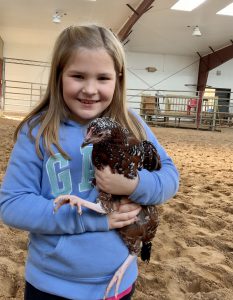
Sussex chickens are a cold-hardy breed. But the coming cold is out of Florida’s norm!
There are several breeds that are hardier to the colder weather. These breeds include: Americauna, Austrolorp, Barnevelder, Brahma, Buckeye, Cochin, Delaware, Dominique, Faverolle, Jersey Giant, Marans, New Hampshire, Orpington, Plymouth Rock, Rhode Island Red, Sussex, Welsummer, and Wyandotte. Now, if you have one of these breeds, it doesn’t mean that you are out of the water. Additional care will need to be taken for all your chicks, no matter their breed.
WATER
Speaking of water, that is one of the main things you will need to be concerned with during the weather that is approaching. “They” are calling for over 34 hours of below freezing temperatures. The main concern for your birds will be heat and water. Your water will freeze over and will need to be checked on several times during the day. Add warm, not hot water to the poultry waterer. If you make it too hot, the chicks may burn themselves. Overnight, it is best to empty the waterers if possible to prevent ice. Refill them in the morning and throughout the day with warm water.
WIND
The strong wind is another concern. The weather advisory is calling the gust of wind that we will experience an “artic blast”. The main thing for your birds is to keep them out of the wind. This does not mean that you need to bring them inside. Simply putting up a block for the north wind will be enough. That block can be a sheet of plywood, some tin or even plastic sheeting. Apply something to the north end of the coop to help keep the wind down. Do not wrap the entire coop, just block the north end. If your coop has a natural north wind block, like bushes or if it is placed on the south side of your garage, you should be fine.
WARMTH
The next item to consider is to give them some warmth. This can be accomplished with a red heat bulb in a clamp light. I found mine on sale at Tractor Supply. The red bulb should be clamped about three to four feet above the floor of the coop. This will prevent any accidental burning of the chicks or the coop. Coop heaters are also available and are safer inside the coop. Another option is hay. Hay will provide warmth for your chicks and help with the chill of the ground. If you use hay, be very careful not to place your heat lamp too close because it could start a fire! The last item to assist with warmth is food. The actual act of eating food will provide warmth to your chicks’ bodies. Make sure they have plenty of food. Remember, scratch or cracked corn is essentially candy for them. Just like any candy, we want to limit how much of that they get. I bet if you mixed a little with their grower crumbles, they would not argue about it.
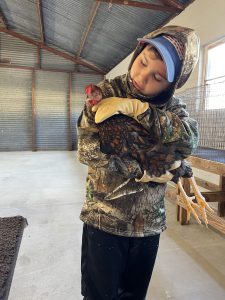 The main thing to remember with this cold snap is that your animals depend on you. Get bundled up and head outside and make sure they have clean, warm water and food. The good news is that we live in Florida and this is only for a couple of days.
The main thing to remember with this cold snap is that your animals depend on you. Get bundled up and head outside and make sure they have clean, warm water and food. The good news is that we live in Florida and this is only for a couple of days.
Enjoy the change in weather and stay warm yourselves.
Prudence Caskey, 4-H Extension Agent II
Santa Rosa County Extension
Institute of Food and Agricultural Sciences
6263 Dogwood Drive
Milton, FL 32570
(850) 623-3868
by Julie Pigott Dillard | Aug 11, 2022
 What is a Growth Mindset?
What is a Growth Mindset?
A vital skill we encourage in 4-H youth is to set goals and objectives to reach those goals. But what happens when they face a challenge that’s hard and scary or when they fail? With so much emphasis placed on achievement, success, and winning, is it possible for us to grow through challenges or failures? Absolutely! And 4-H provides opportunities to do just that. 4-H uses several theories, models, and frameworks to “do” positive youth development. One of the models we use is the 4-H Thriving Model (Arnold, 2018). This model describes what happens when 4-H programs provide the conditions for youth to explore their sparks in a safe environment and are supported by positive relationships with adults and other youth. One of the concepts related to the 4-H Thriving Model is the growth mindset. According to Carol Dweck (2006), our mindset can contribute to our success or our failure. You can think of the mindset as a spectrum. On one end is the fixed mindset and on the other end is the growth mindset.
First, let’s look at the opposite mindset – the fixed mindset and its tendencies:
- Avoids challenges
- Quits/gives up quickly or easily
- Negative self-image/self-talk
- Effort is pointless
- Avoids or ignores feedback or criticism
- Resentful of other’s successes
- Critical and judgmental of others
- Places blame elsewhere/makes excuses.
Conversely, the growth mindset and its tendencies might look like this:
- Embraces challenges
- Doesn’t give up easily/charges ahead
- Is realistic but compassionate to self
- Effort is part of the journey
- Learns from feedback and criticism
- Is inspired by and celebrates the successes of others
- Helpful and caring to others
- Looks for and believes in possibilities.
Why is a Growth Mindset Important?
Youth and adults who have a growth mindset are more motivated to learn, have better relationships, and are more resilient. As individuals, we all fall somewhere on the mindset spectrum. Sometimes we may have a fixed mindset in one area (such as public speaking) but have a growth mindset in another area (such as being a good writer). I’ve seen both mindsets played out many times in the livestock show arena, at shotgun matches, at the Chick Chain poultry show, and at the tailgate grilling contest. One of my senior 4-Hers came in second place in Chick Chain showmanship. Instead of being upset about not winning, his comment was,
“[4-Her] was really good. I learned a lot by watching him, so I know what to practice for next year.”
On the opposite side, I’ve overheard kids (and parents) exclaim something like ‘there’s no use in showing a pig because nobody can beat [4-Her].’ How could you encourage the growth mindset in that moment? By saying something like, “So what can you do differently? Besides winning, what else are you learning?”
As 4-H professionals and volunteers, we can support the development of a growth mindset to help youth thrive. Knowing where youth fall on the mindset spectrum can help you design and scaffold 4-H experiences to develop a growth mindset over time. For example, if we go back to the example of a youth who has a fixed mindset that they are bad at public speaking. As a caring adult, look for other ways that youth can develop confidence in communicating with others. Encourage them to start by using their spark (such as photography, art, or poetry) to communicate with others and share their project experiences. As they become more confident, encourage them to prepare exhibits, deliver team demonstrations, or even serve in a leadership position as an officer or committee chair.
Digging Deeper
Do you know where you are on the mindset spectrum? Before we can help youth thrive, we need to know whether we have a growth mindset or a fixed mindset. Take this assessment to determine where you fall on the mindset spectrum http://blog.mindsetworks.com/what-s-my-mindset.
To learn more about growth mindset, I highly recommend Mindset: The New Psychology of Success by Carol S. Dweck, PhD. I challenge you to implement these tips with your 4-Hers this year!
References:
Arnold, M. E. (2018). From context to outcomes: Adolescent thriving in 4-H Youth Development Programs. Journal of Human Science and Extension, 6(1), 141-160.
Dweck, C. S. (2006). Mindset: The new psychology of success. Random House.
by Julie Pigott Dillard | Jun 10, 2022
With temperatures already posting in the 90s this month, it’s a good idea to make sure your backyard chickens are ready for the coming summer heat. Poultry can become heat stressed when temperatures rise above 80 degrees Fahrenheit. Heat stress affects egg production as well as size, shell quality, and hatchability. It also affects appetite and growth in younger birds.

Add ice cubes to your chickens water to cool them down.
To minimize heat stress in your backyard flock, there are several things you can do.
- Make sure your coop is well ventilated for cross air movement. Trim vegetation and limbs that might block air flow. You can also add a fan to help move air throughout the coop.
- Locate your coop in a shaded area surrounded by grass. Grass reduces light reflection into the coop.
- Provide cool water in shaded locations for your birds. Ice cubes and frozen water bottles can help cool water down. Feed consumption will likely decrease during this time but shouldn’t give you alarm.
- Provide occasional frozen treats like watermelon and peas. Fill a container with fruit or vegetables, add water, and freeze. The chickens will peck at it as it thaws.
- Misters, shallow wading pools, and dust baths can help chickens cool down.

Chickens pant to dissipate heat from their bodies.
Chickens don’t sweat. Instead, they dissipate heat from their wattles, legs, under the wings and through panting. Watch out for signs of heat stress that might include
- heavy panting
- wings held out from the body
- lethargic, sluggish behavior
- pale combs and wattles.
To learn more about keeping your backyard chickens healthy during the summer, contact your local UF/IFAS Extension office.
by Julie Pigott Dillard | Mar 18, 2022

Pullet Grand Champion Audrey S.
4-Hers from across the Northwest Extension District wrapped up their 2021-2022 4-H Chick Chain projects at the district show on March 12th. In October, the 4-Hers began caring for their baby chicks in a brooder then transitioned them to a coop. They learned poultry showmanship skills and how to bathe their birds and make them look their best for their show throughout the project. They also learned biosecurity basics to protect their birds and themselves from disease and illness.
The NWD District Chick Chain Show is the culminating experience for this project. After checking in their birds, 4-Hers participated in a skill-a-thon to test their poultry science knowledge. The showmanship contest gave them a chance to show off how they check their birds health, present their bird to the judge, and explain how they care for and prepare their birds for show.
Congratulations to our 2021-2022 4-H Chick Chain Project 4-Hers. Below are the final results for the show.

Pullet Grand Champion Audrey S. & Reserve Ryder H.

Senior Skill-a-thon 2nd place Owen B. &; 1st place Roger N.

Blue ribbon photography Catherine G. &; Alison C.

Junior Showmanship 1st place Kadence A., 2nd place Jocelyn B., 3rd place Kasen M.
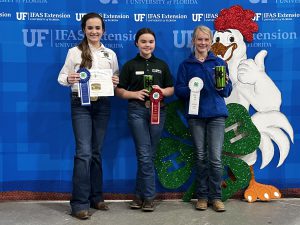
Intermediate Showmanship 1st place Emma W., 2nd place Emily F., 3rd place Adly C.

Senior Showmanship winners 2nd place Owen Bender, 1st place Roger Nemeth
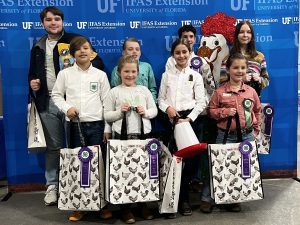
Best of Breed Winners-Australorp-Blair P., Brahma-Audrey S., Delaware-Samuel R., Plymouth Rock-Jocelyn B., Orpington-Ryder H., Rhode Island Red-Riley B., Sussex-Aubrey M., Wyandotte-Owen B.
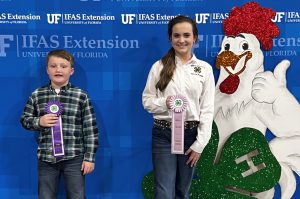
Production Division-Grand Champion Colton H. & Reserve Emma W.



















